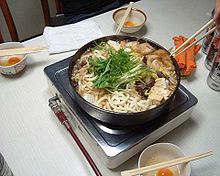Sukiyaki
Sukiyaki ( Japanese 鋤 焼 or す き 焼 き ) is a stew (Japanese nabemono ) used in Japanese cuisine , consisting of thinly sliced beef , tofu , konnyaku noodles , leek , onions , Chinese cabbage and enoki mushrooms. The ingredients are in a cast iron pot in soy sauce , sugar and mirin simmered. Before eating, the ingredients are dipped in a bowl with a whisked egg. Sukiyaki is usually prepared right at the table.
Variations
As with other stews, every region in Japan has its own preparation preferences. For example, in the Kantō region, soy sauce, sugar and mirin are mixed in the kitchen, whereas in the Kansai region the sauce is mixed at the table.
season
Sukiyaki, like fondue, is a dish for the cold days of the year and is very often on the menu at Japanese Bōnenkai parties (year-end parties).
history
To make work in the rice fields easier, cattle were imported from the Korean peninsula to Japan in the 2nd century . Cattle were only viewed as pack animals , u. a. since Buddhist law forbade killing four-legged friends for food production (strictly speaking, "sentient beings" in general). However, the meat ban in pre-modern and early modern Japan was only partially religious in nature. Bans on meat consumption served in ancient times, but also in the Tokugawa period, to preserve the animal populations, which were already sparse, and to promote agriculture. However, the consumption of game and forest birds also occurred in the Tokugawa period. The Buddhist meat taboo was strengthened by the Shinto purity law, according to which slaughter was considered unclean.
Only soldiers were given beef during wartime to keep them healthy. The soldiers returning home from the war prepared their new favorite food in the field with the help of plowshares over hot coals, so as not to offend the older generation, as cooking beef in the house was viewed as a sacrilege. This is how Sukiyaki, which means to fry on plowshares in German , got his name. After prolonged contact with the West during the Meiji period , beef gradually lost its bad reputation. When the emperor himself began to eat meat in the western style, his subjects soon followed suit. During this time, Sukiyaki developed into its current form.
